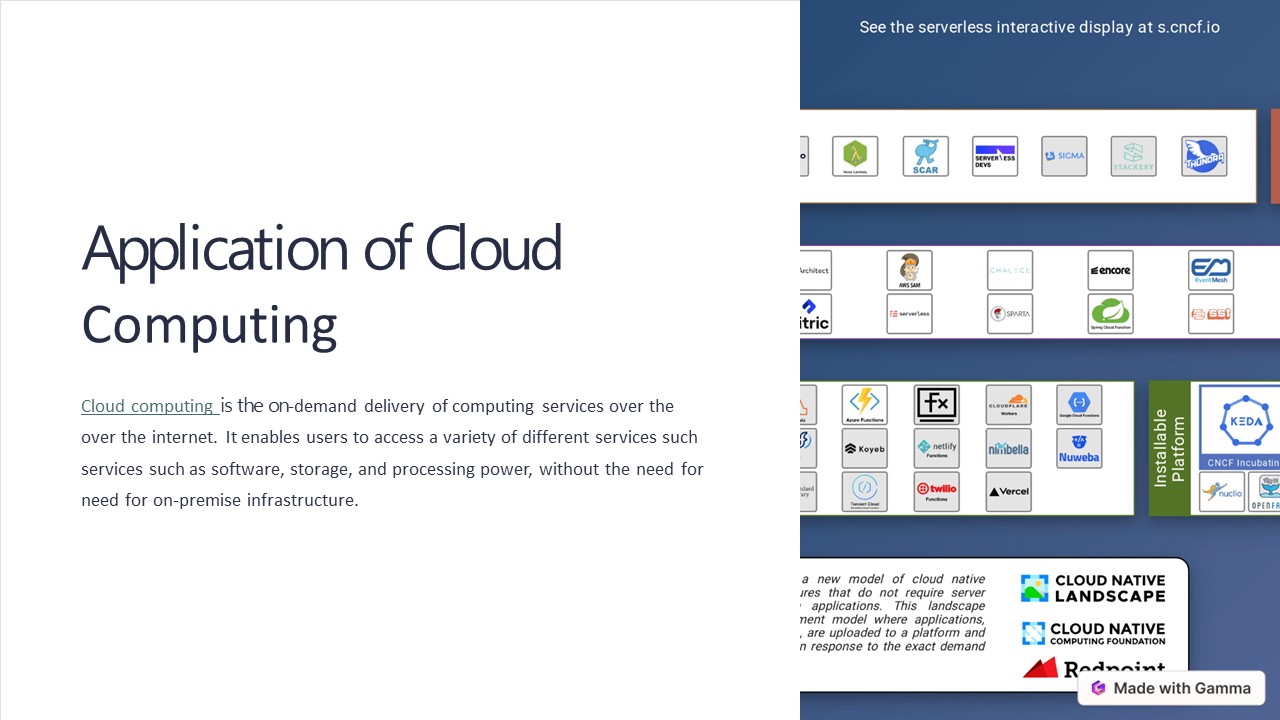Application of Cloud Computing - PowerPoint PPT Presentation
Title:
Application of Cloud Computing
Description:
Cloud computing is a term that refers to the use of on-demand, self-service models of computing resources. This concept is usually used to describe a network of remote servers managed by a cloud provider. These servers are offered to businesses and individuals that need computing power on demand, without the need to invest in their own hardware. The cloud providers offer the computing power as a service, which is often less expensive than owning and operating a physical server. The cloud provider manages the hardware and software, providing it to the end user. – PowerPoint PPT presentation
Number of Views:3
Title: Application of Cloud Computing
1
Application of Cloud Computing
Cloud computing is the on-demand delivery of
computing services over the internet. It enables
users to access a variety of different services
such as software, storage, and processing power,
without the need for on-premise infrastructure.
2
Overview of Cloud Computing Models
1
2
3
Infrastructure as a Service (IaaS)
Platform as a Service (PaaS)
Software as a Service (SaaS)
IaaS delivers computing infrastructure in a
virtualized environment, enabling users to access
resources such as servers, storage and networking.
PaaS provides a platform for developers to build,
test, and deploy applications without having to
set up and manage the underlying infrastructure.
SaaS provides access to software applications via
the internet, eliminating the need to install and
run software on individual devices.
3
Benefits of Cloud Computing
Cost Savings ??
Scalability ??
Accessibility ??
Cloud computing eliminates the need for expensive
on-premise hardware and maintenance. Users pay
only for what they need, when they need it.
Cloud computing allows users to instantly scale
resources up or down as needed, enabling them to
handle spikes in traffic or usage.
Cloud computing provides access to computing
resources from anywhere in the world, as long as
there is an internet connection.
4
Challenges of Cloud Computing
Security
Downtime
Ensuring the security of cloud-hosted assets and
data is a major challenge for cloud computing.
Organizations must take measures to protect
against cyber-attacks and data breaches.
Cloud service providers can experience outages
and service disruptions that can impact user
productivity and result in lost revenue.
5
Applications of Cloud Computing
1
Data Analytics ??
Cloud computing provides the ability to store and
analyze large amounts of data, enabling
organizations to make more informed business
decisions.
2
IoT ??
Internet of Things (IoT) devices generate large
amounts of data that can be collected and
analyzed in the cloud, enabling organizations to
gain insights and improve operations.
3
Machine Learning ??
Cloud computing provides the computational power
needed to train machine learning models, enabling
organizations to develop predictive models and
make more accurate business decisions.
4
Backup and Recovery ??
Cloud computing provides a cost-effective way for
organizations to back up and recover data in the
event of a disaster or data loss.
6
Real-world Examples of Cloud Computing
Spotify
Netflix
Lyft
Spotify uses the cloud to host and distribute its
music streaming service to millions of users
around the world.
Netflix uses the cloud to host and deliver its
streaming video service to millions of users
around the world.
Lyft uses the cloud to host and manage its
ride-sharing platform, which connects drivers
with riders using mobile devices.
7
Future of Cloud Computing
1
2
Increased Adoption ??
Hybrid Cloud ??
Cloud computing is expected to become even more
ubiquitous in the coming years as organizations
increasingly turn to the cloud for their
computing needs.
Many organizations are likely to adopt hybrid
cloud architectures that combine on-premise
infrastructure with cloud-based resources to
achieve the best of both worlds.
3
Edge Computing ??
The rise of edge computing is likely to result in
the adoption of cloud computing architectures
that enable processing to take place closer to
the edge of the network, reducing latency and
improving performance.
8
Application of Cloud Computing
9
(No Transcript)































